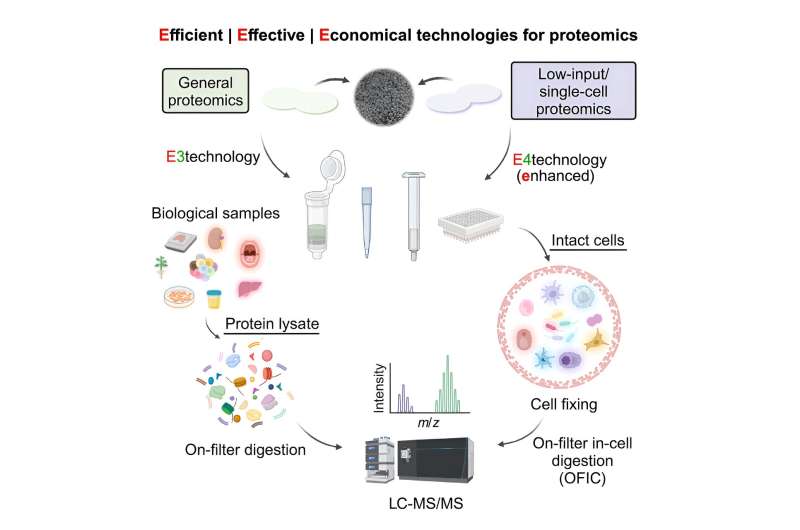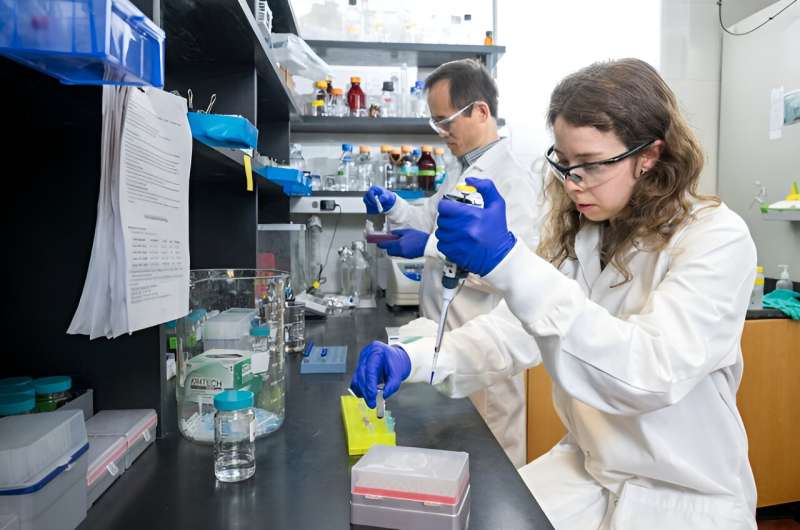This article has been reviewed according to Science X's editorial process and policies. Editors have highlighted the following attributes while ensuring the content's credibility:
fact-checked
peer-reviewed publication
trusted source
proofread
Scientists develop an easier, less expensive technology for proteome analysis

Proteins are workhorses that carry out most of the biological functions in our cells. While the genes we inherit from our parents, our so-called genome, are fixed and usually remain unchanged throughout our lives, proteins in our bodies are constantly changing, as we age, under different health conditions and upon stimulation, such as with medical treatment.
This makes monitoring proteins and their molecular changes—the study of proteomics—beneficial for drug discovery, disease diagnosis and health management. It also could one day open the door toward precision medicine.
Yanbao Yu, director of proteomics in the University of Delaware's Department of Chemistry and Biochemistry, has developed a simplified method for preparing protein samples for proteomics analysis that is quick, easy-to-use, inexpensive and universally compatible with other parts of the process.
Yu and his collaborators reported the UD patent-pending method's effectiveness in a paper published June 11 in the journal Cell Reports Methods.
A word about proteomics
Knowing about the number or composition of proteins in our cells can help researchers understand what is going on inside our bodies, at a specific time or even over time. For example, the presence or absence of certain proteins can be an indicator of a person's biology.
"Simply speaking, if a protein is present only when people are sick, then this protein can be used as an indicator, or a biomarker, for disease," Yu said.
Proteomics scientists like Yu use a highly sensitive instrument called a mass spectrometer to determine the identity of specific proteins. Processing samples of blood, tissue or other biological material to make them compatible and readable by mass spectrometry is a critical part of the process.
This is where Yu's work comes in.
A simpler method with good results
Yu's method simplifies the preparation of samples in a way that is efficient, effective and economical, a trifecta that he terms E3. He protected the patent-pending method through UD's Office of Economic Innovation and Partnerships (OEIP). CDS Analytical, LLC, a leading supplier of proteomics sample preparation consumables and instruments, has an exclusive license for full commercial rights to the patent-pending UD technology.
Combined with CDS Analytical's Empore membrane, the method offers a simple-to-use, less-costly platform to prepare samples for testing, compared to other products on the market. The platform technology can be used across multiple sample-collection devices, such as filters, pipettes, cartridges or plates.
"This is really an easy-to-use technique," Yu said. "You don't need a Ph.D. degree to feel confident enough to do proteomics. We have made the method very robust and reliable, so every lab scientist can do high-quality protein preparation."
Products used to prepare these types of biological samples are typically expensive. One of the goals was to make it more affordable than what is currently available in the marketplace, bringing the price of proteomics experiments closer to the cost of genomics experiments, where it can have a big impact on precision medicine and health care costs.
"The processing is the focus of our technology," Yu said. "If we can reduce the cost for the necessary chemical reagents and supplies now, it can benefit all patients in the future if these tests can be done with mass spectrometry."
Yu and his colleagues initially benchmarked a variety of formats and sample types and validated the platform technology's performance on a variety of samples, from those that were complex to samples containing a low number of cells. The research team initially studied the platform's performance using E. coli, a bacteria with a well-known proteome.
Further studies validated the technology's usefulness for preparing all different types of biological material samples for analysis, from wetland bacteria to fungi, saliva, tissue or human cells. The overall data showed the UD-developed method and resulting technology platform to be equivalent or superior to many existing methods.
CDS Analytical commercialized and began selling the novel proteomics sample preparation products in December 2023.
"We are glad to have this opportunity to commercialize this revolutionary technology from University of Delaware for proteomics digestion and related steps to solve the bottleneck of proteomics sample preparation," said CDS Analytical Empore Division Manager Guotao Lu.
"Together with CDS Analytical Empore line's StageTips technology and the MiniLab 5000 liquid handler, our goal is to build a one-stop solution for proteomics sample preparation from cells to LC-MS to help improve the efficiency and save cost for proteomics analysis, and to enable scientists to explore and understand biological systems more effectively. We are thrilled to contribute to this revolutionary technology of proteomics, aiming to accelerate scientific breakthroughs in deep mechanistic human biology to address unmet medical needs of patients."

Answering critical biological questions
UD molecular biologist Mona Batish studies the biology of RNA, single-stranded ribonucleic acid molecules made by the DNA in our bodies. Batish used Yu's method to identify RNA-binding proteins (RBP) that interact with a type of non-coding RNA found in our cells called circular RNA.
Circular RNA can persist in the body over long time periods, where they can regulate gene expression, act as tumor suppressors and cause resistance or susceptibility to things like chemotherapy.
RBPs, Batish said, are key to many cellular processes and ultimately help determine where RNA molecules will localize and be able to carry out their functions in a cell. She wanted to better understand how circular RNA bind to RBPs, which is critical to fully understand the potential use of circular RNAs as biomarkers or therapeutic targets for diseases.
"It's tedious to find RNA-binding proteins, particularly when they are in low abundance, but Yanbao's technology helped to overcome this issue and gave us really good target data," said Batish. "It's also very reproducible, which is the biggest factor when we're talking about any new biological finding. We found very good consistency across the samples with this new technology, as compared to what we had done in the past."
Effective for limited-quantity environmental samples
UD geologist Clara Chan and Jessica Keffer, an associate scientist in her lab, work with iron-oxidizing bacteria that produce rust, which are minerals with many important environmental functions. These iron-oxidizing bacteria are found in soil, wetlands, water treatment systems, beach sediments, even at the bottom of the ocean.
The researchers want to understand what proteins these iron-oxidizing bacteria use to form the rust minerals, but the organisms are difficult to culture and analyze.
An earlier proteomics study done by the Chan lab detected very few proteins overall, leaving them with limited data. Keffer previously used a detergent to break them open to release the proteins and other material inside, a process known as cell lysis. But this method can lead to sample loss if the cells don't break properly or if the detergent has poor effects on the protein they are trying to recover. Using a centrifuge to collect the cells by spinning them at high speed also wasn't an option.
It's a common problem. Minimizing sample loss of difficult-to-obtain specimens is a key challenge, whether researchers are working with biological or environmental samples.
"Proteins can easily adsorb, or stick, to plastics. So, more pipetting and transferring liquids means more sample loss," said Yu. "Ideally, you want to process such precious samples in a small volume in a single device."
In the paper, Yu demonstrates proof-of-principle data using a few thousand cells to show this is possible with enhancements to the UD-developed method.
To address this for Keffer, Yu suggested skipping the cell lysis steps and instead using the enhanced version of his team's technology platform to do the reactions and processing directly inside the cell.
With the UD-developed method, Keffer was able to recover a high number of peptides and proteins from a smaller sample volume than she had ever worked with before. It's a promising development, since it means that in future studies, she wouldn't need to grow as large a number of cells in order to achieve quality data.
"In the current data set that I'm working with, we detected about 78% of the total predicted proteins from our organism. That's more proteins than we had ever seen in any previous attempts," Keffer said. "The data was also very high quality. When we replicated the studies, the data was very similar, which is important so that we can be confident in what we're seeing."
This type of information has the potential to inform what researchers know about whether other organisms have this rust-producing capability or lead to technologies that leverage these proteins to create desired environmental changes or to make new materials.
Chan called the new technology platform promising.
"Being able to detect the proteins and the actual amount of the proteins present helps us make conclusions about what they're doing," she said. "If we can do it in cultures that don't grow very well, maybe we can go to the environment and get a more complete picture of what's happening than what current environmental proteomics can tell us."
Next steps for Yu in this work include applying the technology to more biological systems and to answer questions that are more relevant to human health, such as viral infection and cancer.
In the future, Yu hopes to see the products adopted and used by researchers in the proteomics community, and potentially by clinicians or health care technicians to do daily diagnosis and screening in a simple and consistent manner.
More information: Development of an Efficient, Effective, and Economical Technology for Proteome Analysis, Cell Reports Methods (2024). DOI: 10.1016/j.crmeth.2024.100796. www.cell.com/cell-reports-meth … 2667-2375(24)00152-8
Journal information: Cell Reports Methods
Provided by University of Delaware





















